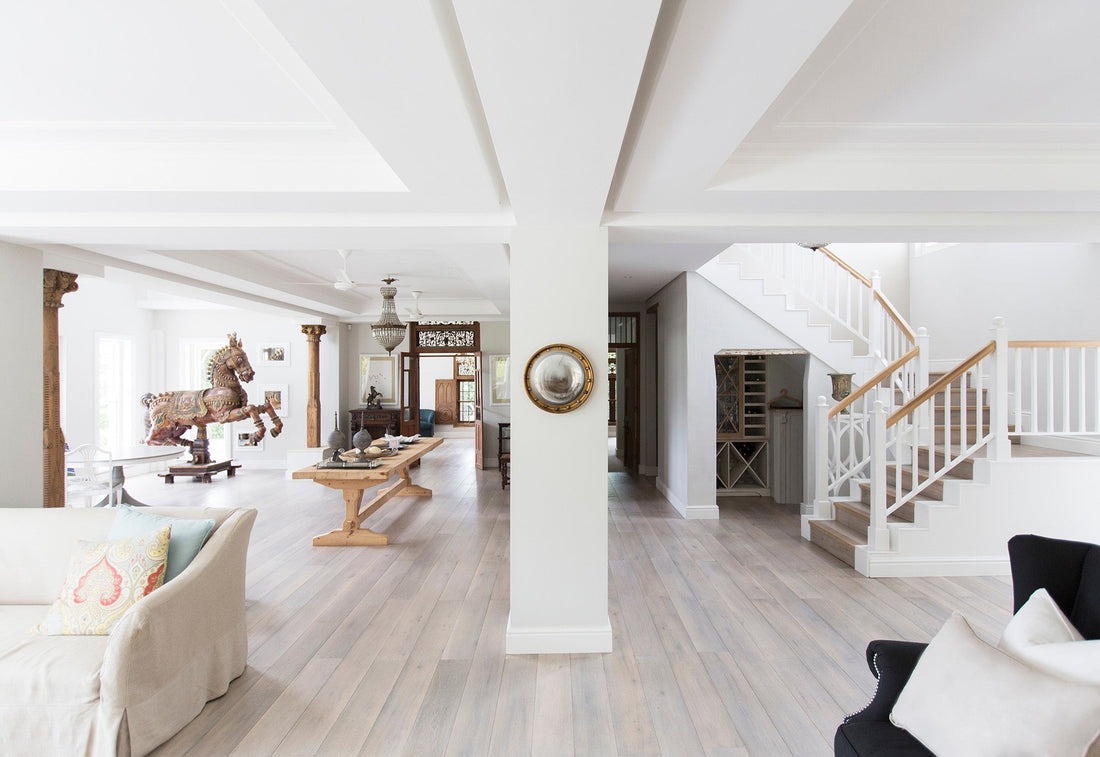
Waterproof & Water Resistant Flooring: Understanding the Nuances of Each
Share
When choosing flooring for moisture-prone areas like bathrooms, kitchens, basements, and laundry rooms, the terms waterproof and water resistant are frequently encountered.
While both offer protection against spills and humidity, the degree and duration of that protection differ significantly. Understanding; what is the difference between waterproof and water resistant flooring is essential for selecting the right flooring that will withstand the specific moisture challenges of your space and provide long-lasting performance.
What Does Water Resistant Mean?
Water Resistant Floors are designed to repel water for a certain period. They can withstand splashes and spills if cleaned up promptly. However, prolonged exposure to moisture or standing water can penetrate the surface and potentially damage the flooring material.
Characteristics of Water Resistant Floors:
- Repels Surface Moisture: Can handle spills and splashes if cleaned quickly.
- Limited Protection Against Prolonged Exposure: Not designed for standing water or high humidity over extended periods.
- May Swell or Warp: The core materials can absorb moisture and lead to swelling, warping, or other damage if exposed for too long.
- Suitable for Areas with Occasional Spills: Generally appropriate for areas where spills are likely but are typically cleaned up quickly.
Examples of Water Resistant Floors:
Laminate Flooring (Standard): While the wear layer offers some protection, the core board (usually HDF) can absorb water and swell if exposed for an extended time. Some newer laminates offer enhanced water resistance for a limited period.
Engineered Hardwood: While the top layer is real wood, the core layers are often plywood or MDF, which can be damaged by prolonged moisture exposure. Some engineered hardwood options offer increased moisture resistance.
What is Waterproof Flooring?
Waterproof Floors, on the other hand, are engineered to be completely impervious to water. They can withstand spills, standing water, and high humidity without damage. Their core materials and construction prevent water from penetrating and causing swelling, warping, or mold growth.
Characteristics of Waterproof Floors:
- Impervious to Water: Can withstand spills, standing water, and high humidity without damage.
- Prevents Swelling and Warping: The core materials are typically made of waterproof polymers or composites.
- Suitable for All Areas, Including Wet Rooms: Ideal for bathrooms, kitchens, basements, and laundry rooms where moisture exposure is likely.
- Often Feature Waterproof Locking Systems: The way the planks or tiles connect is also designed to prevent water from seeping through.
Examples of Waterproof Floors:
Luxury Vinyl Plank (LVP): Constructed with a 100% waterproof core, LVP is a popular choice for areas prone to moisture.
Luxury Vinyl Tile (LVT): Similar to LVP, LVT offers complete waterproof protection and comes in tile and stone looks.
Waterproof Laminate: Engineered with a waterproof core and a tight locking system to prevent water penetration.
Tile (Ceramic and Porcelain): When properly installed with sealed grout, tile is completely waterproof.

What is the Difference Between Waterproof vs. Water Resistant Flooring
The fundamental Waterproof Floors vs Water Resistant Floors difference lies in their ability to handle prolonged moisture exposure:
Duration of Protection:
Water-resistant floors offer short-term protection against spills, while waterproof floors can withstand long-term exposure to moisture and even standing water.
Core Material:
The core of a water-resistant floor is typically made of materials that can absorb water over time, whereas the core of a waterproof floor is made of impervious materials.
Suitability for Wet Areas:
Waterproof floors are ideal for bathrooms, kitchens, basements, and laundry rooms, while water-resistant floors are better suited for areas with occasional spills that are promptly cleaned.
Warranty:
Waterproof floors often come with warranties that specifically cover water damage, while water-resistant floors typically do not offer this level of protection.
Choosing Between Waterproof vs Water Resistant Flooring
The decision between waterproof vs water resistant flooring depends on the specific needs of the room:
High Moisture Areas (Bathrooms, Laundry Rooms, Basements):
Waterproof flooring is the clear choice to prevent damage from spills, humidity, and potential flooding.
Kitchens:
While spills are common, they are usually cleaned up quickly. However, for maximum protection, waterproof options like LVP or tile are highly recommended. Water-resistant laminate might be considered with caution and a strict cleaning routine.
Living Rooms, Bedrooms, Hallways:
Water-resistant options like standard laminate or engineered hardwood are generally sufficient, as these areas are less prone to significant moisture exposure. However, if you have pets or young children, waterproof options can offer added peace of mind.
Talk to the Laminate Experts in Buford, GA - Flooring Attic
Understanding the critical differences between Waterproof Floors vs Water Resistant Floors is essential for making an informed flooring decision, especially for areas prone to moisture. While water-resistant floors can handle occasional spills, waterproof floors offer complete protection against water damage, making them the ideal choice for bathrooms, kitchens, basements, and laundry rooms. Consider the specific moisture challenges of your space and choose accordingly to ensure long-lasting beauty and performance.
Flooring Attic in Buford, GA, offers a wide selection of both waterproof and water-resistant laminate flooring options throughout the Southeast. Our experts can help you determine the best choice for your specific needs and budget. Contact or visit Flooring Attic in Buford, GA, to explore our extensive range of waterproof and water-resistant flooring options and receive expert guidance across the Southeast.
